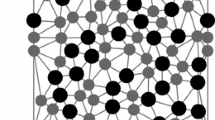Abstract
Monte-Carlo simulations of the fracture of elastic unidirectional model fibre composites are an important tool to understand composite reliability. On account of being computationally intensive, fracture simulations reported in the literature have been limited to simulation patches comprised of a few thousand fibres. While these limited patch sizes suffice to capture the dominant failure event when the fibre strength variability is low (synthetic fibres), they suffer from edge effects when the fibre strength variability is high (natural fibres). On the basis of recent algorithmic developments based on Fourier acceleration, a novel bisection based Monte Carlo failure simulation algorithm is presently proposed. This algorithm is used to obtain empirical strength distributions for model composites comprised of up to \(2^{20} \approx 10^6\) fibres, and spanning a wide range of fibre strength variabilities. These simulations yield empirical weakest-link strength distributions well into the lower tail. A stochastic model is proposed for the weakest-link event. The strength distribution predicted by this model fits the empirical distributions for any fibre strength variability.






Similar content being viewed by others
References
Alava MJ, Nukala PK, Zapperi S (2006) Statistical models of fracture. Adv Phys 55(3–4):349–476
ASTM (2017) Standard test methods for tensile properties of polymer matrix composite materials. Standard D 3039, ASTM international, West Conshohocken, PA
Batrouni GG, Hansen A, Nelkin M (1986) Fourier acceleration of relaxation processes in disordered systems. Phys Rev Lett 57(11):1336
Beyerlein IJ, Phoenix SL, Sastry AM (1996) Comparison of shear-lag theory and continuum fracture mechanics for modeling fiber and matrix stresses in an elastic cracked composite lamina. Int J Solids Struct 33(18):2543–2574
Cormen T, Leiserson C, Rivest R, Stein C (2001) Introduction To algorithms. MIT Press, Cambridge
Curtin W (1998) Size scaling of strength in heterogeneous materials. Phys Rev Lett 80(7):1445
Curtin W (2000) Dimensionality and size effects on the strength of fiber-reinforced composites. Compos Sci Technol 60(4):543–551
Daniels H (1945) The statistical theory of the strength of bundles of threads. I. Proc R Soc Lond A 183(995):405–435
Eaton JW, Bateman D, Hauberg S, Wehbring R (2015) GNU octave version 4.0.0 manual: a high-level interactive language for numerical computations. CreateSpace Independent Publishing Platform. URL http://www.gnu.org/software/octave/doc/interpreter
Fidelis MEA, Pereira TVC, Gomes OdFM, de Andrade Silva F, Toledo Filho RD (2013) The effect of fiber morphology on the tensile strength of natural fibers. J Mater Res Technol 2(2):149–157
Gücer D, Gurland J (1962) Comparison of the statistics of two fracture modes. J Mech Phys Solids 10(4):365–373
Gupta A, Mahesh S, Keralavarma SM (2017a) A fast algorithm for the elastic fields due to a single fiber break in a periodic fiber-reinforced composite. Int J Fract 204(1):121–127
Gupta A, Mahesh S, Keralavarma SM (2017b) Strength distribution of large unidirectional composite patches with realistic load sharing. Phys Rev E 96:043,002
Gupta A, Mahesh S, Keralavarma SM (2018) A fast algorithm for the elastic fields due to interacting fibre breaks in a periodic fibre composite. Int J Fract 211(1–2):295–303
Habeeb CI, Mahesh S (2015) Strength distribution of planar local load-sharing bundles. Phys Rev E 92(2):022,125
Hedgepeth JM (1961) Stress concentrations in filamentary structures. Technical report TN D 882, NASA
Hedgepeth JM, Van Dyke P (1967) Local stress concentrations in imperfect filamentary composite materials. J Compos Mater 1(3):294–309
Hull D, Clyne T (1996) An introduction to composite materials. Cambridge University Press, Cambridge
Jawaid M, Khalil HA (2011) Cellulosic/synthetic fibre reinforced polymer hybrid composites: a review. Carbohydr Polym 86(1):1–18
Landis C, McMeeking R (1999) Stress concentrations in composites with interface sliding, matrix stiffness and uneven fiber spacing using shear lag theory. Int J Solids Struct 36(28):4333–4361
Landis CM, Beyerlein IJ, McMeeking RM (2000) Micromechanical simulation of the failure of fiber reinforced composites. J Mech Phys Solids 48(3):621–648
Mahesh S, Mishra A (2018) Strength distribution of Ti/SiC metal-matrix composites under monotonic loading. Eng Fract Mech 194:86–104
Mahesh S, Phoenix S (2004) Absence of a tough-brittle transition in the statistical fracture of unidirectional composite tapes under local load sharing. Phys Rev E 69(2):026,102
Mahesh S, Beyerlein IJ, Phoenix SL (1999) Size and heterogeneity effects on the strength of fibrous composites. Physica D Nonlinear Phenom 133(1):371–389
Mahesh S, Phoenix SL, Beyerlein IJ (2002) Strength distributions and size effects for 2D and 3D composites with weibull fibers in an elastic matrix. Int J Fract 115(1):41–85
McCartney L, Smith R (1983) Statistical theory of the strength of fiber bundles. J Appl Mech 50(3):601–608
Mishra A, Mahesh S (2017) A deformation-theory based model of a damaged metal matrix composite. Int J Solids Struct 121:228–239
Okabe T, Takeda N (2002) Elastoplastic shear-lag analysis of single-fiber composites and strength prediction of unidirectional multi-fiber composites. Compos A 33(10):1327–1335
Okabe T, Takeda N, Kamoshida Y, Shimizu M, Curtin W (2001) A 3D shear-lag model considering micro-damage and statistical strength prediction of unidirectional fiber-reinforced composites. Compos Sci Technol 61(12):1773–1787
Smith R (1980) A probability model for fibrous composites with local load sharing. Proc R Soc Lond A 372(1751):539–553
Smith R, Phoenix S, Greenfield M, Henstenburg R, Pitt R (1983) Lower-tail approximations for the probability of failure of three-dimensional fibrous composites with hexagonal geometry. Proc R Soc Lond A 388(1795):353–391
Tange O (2011) Gnu parallel–the command-line power tool. Login USENIX Mag 36(1):42–47. https://doi.org/10.5281/zenodo.16303
Weibull W (1951) A statistical distribution function of wide applicability. J Appl Mech 103(730):293–297
Zhang J, Wang F (2009) Modeling of progressive failure in ductile matrix composites including local matrix yielding. Mech Adv Mater Struct 16(7):522–535
Zhou S, Curtin W (1995) Failure of fiber composites: a lattice green function model. Acta Metall Mater 43(8):3093–3104
Author information
Authors and Affiliations
Corresponding author
Additional information
Publisher's Note
Springer Nature remains neutral with regard to jurisdictional claims in published maps and institutional affiliations.
Rights and permissions
About this article
Cite this article
Mahesh, S., Gupta, A., Kachhwah, U.S. et al. A fast algorithm to simulate the failure of a periodic elastic fibre composite. Int J Fract 217, 127–135 (2019). https://doi.org/10.1007/s10704-019-00374-w
Received:
Accepted:
Published:
Issue Date:
DOI: https://doi.org/10.1007/s10704-019-00374-w




